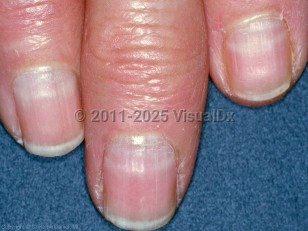Arsenic poisoning
See also in: Nail and Distal DigitAlerts and Notices
Important News & Links
Synopsis

Environmental intoxication occurs mostly in rural settings. Pesticides, fungicides, and insecticides may contain arsenic (copper acetoarsenite, calcium, or lead arsenite). Surface soils and ground drinking water can contain high levels of arsenic. The use of pressure-treated plywood containing a chromium-copper arsenate, ammoniacal copper arsenate, or ammoniacal copper-zinc arsenate treatment could lead to intoxication. Occupational exposure is seen in workers in the mining, smelting, semiconductor production, and glassmaking industries. Some herbal and homeopathic remedies as well as some illegally distilled alcohols ("moonshine") can contain arsenic. Chronic exposure can occur through contaminated drinking water.
Acute poisoning can occur from either inhalation or ingestion. With exposure to large amounts of inorganic arsenic, symptoms may develop within minutes to hours. Initial symptoms are generally gastrointestinal (GI) and include abdominal pain, nausea, vomiting, and severe watery diarrhea. Intoxicated patients may have a "garlicky" odor to their breath and/or stool. Patients develop dehydration and hypotension as well as cardiac dysrhythmias with QT-interval prolongation and torsades de pointes. Acute encephalopathy may develop, as can renal injury. If severely poisoned individuals survive their acute intoxication, they can go on to develop hepatitis, pancytopenia, and peripheral neuropathy (which can mimic Guillain-Barré syndrome).
Signs and symptoms of chronic poisoning, which is more likely from environmental / occupational ingestion, include nausea, vomiting, anorexia, weight loss, "raindrop" hypomelanosis, hyperkeratosis punctata (ie, arsenical keratoses of the palms and soles), cutaneous neoplasms (eg, basal cell carcinomas, Bowen disease – often multiple and commonly in areas of the skin without sun exposure), sensory motor distal neuropathy, liver failure, renal failure, and encephalopathy.
Transverse white bands across nails are called Mees' lines. They occur approximately 2-3 weeks after acute arsenic poisoning and are located above the lunulae. The Mees' lines form due to the deposition of arsenic in the nails.
Chronic arsenic exposure is associated with increased rates of certain cancers including skin cancers, bladder cancers, renal cancers, lung cancers, liver cancer, and prostate cancer.
Acute arsenic poisoning may occur over a period of days to weeks. Chronic arsenic poisoning may occur over a period of months to years. Arsenic poisoning is most common in adults. Accidental and environmental exposure occurs equally in both sexes; however, occupational exposure is more common in men.
Codes
T57.0X1A – Toxic effect of arsenic and its compounds, accidental (unintentional), initial encounter
SNOMEDCT:
767146004 – Toxic effect of arsenic and its compounds
Look For
Subscription Required
Diagnostic Pearls
Subscription Required
Differential Diagnosis & Pitfalls

Subscription Required
Best Tests
Subscription Required
Management Pearls
Subscription Required
Therapy
Subscription Required
Drug Reaction Data
Subscription Required
References
Subscription Required
Last Updated:02/29/2024

